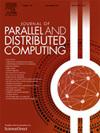ERT:基于P2P存储系统的估计响应时间的数据放置
IF 3.4
3区 计算机科学
Q1 COMPUTER SCIENCE, THEORY & METHODS
引用次数: 0
摘要
采用P2P架构的存储系统是传统客户机-服务器系统的一种替代方案,在消除单点故障的同时提供更好的可伸缩性和容错性。异构节点P2P存储系统面临着性能和可扩展性方面的挑战,其中一个主要原因是其数据放置方式。现有的数据放置方法,如Kademlia协议的实现,将数据存储在最近的节点上,其中通过数据标识符与节点之间的按位异或操作来测量距离。这种方法是高度可伸缩的,因为它不需要全局知识来放置和检索数据。但是,它没有考虑节点的异构性能,这可能导致资源使用不平衡。其他工作实现了基于标准的节点选择,解决了节点的异质性。但是,这种方法通常会导致后续的数据检索需要对数据位置有全局的了解。本文介绍了一种基于响应时间估计的数据放置方法,该方法基于对节点响应时间的动态估计,将数据存储到选定的节点上。ERT使用排队理论对数据放置过程进行建模。此外,它还结合了预测响应时间和其他标准,用于节点选择决策。在实际P2P存储系统中的实验结果表明,ERT将节点的响应时间标准差比原生Kademlia降低了17.57%,比虚拟节点Kademlia降低了39.01%,比基于吞吐量的数据放置降低了49.24%。此外,依赖于Kademlia修改的DHT数据结构允许ERT在数据检索过程中消除对全局知识的需求。本文章由计算机程序翻译,如有差异,请以英文原文为准。
ERT: Data placement based on estimated response time for P2P storage systems
Storage system using P2P architecture is an alternative to traditional client-server system that offers better scalability and fault tolerance while eliminating the single point of failure. P2P storage systems with heterogeneous nodes face performance and scalability challenges, one of which is contributed by their data placement method. Existing data placement methods, such as the implementation of the Kademlia protocol, store data at the closest node, where the distance is measured by bitwise XOR operation between identifiers of data and the node. This approach is highly scalable because it does not require global knowledge for placing and retrieving the data. It does not however consider the heterogeneous performance of the nodes, which can result in imbalanced resource usage. Other works implement criteria-based node selection that addresses the heterogeneity of nodes. However, such approaches often cause subsequent data retrieval to require global knowledge of the data location. This paper introduces a novel data placement method called Estimated Response Time-based (ERT), which stores data to selected nodes based on dynamic estimation of nodes response time. ERT models the data placement process using queueing theory. Besides, it incorporates the predicted response time, alongside other criteria, for node selection decision-making. The experimental results in a real P2P storage system indicate that ERT reduces the standard deviation of response time of nodes by 17.57% compared to the native Kademlia, 39.01% compared Kademlia with Virtual Node, and by 49.24% compared to Throughput-based data placement. Further, relying on a modified DHT data structure of Kademlia allows ERT to eliminate the need for global knowledge during data retrieval.
求助全文
通过发布文献求助,成功后即可免费获取论文全文。
去求助
来源期刊

Journal of Parallel and Distributed Computing
工程技术-计算机:理论方法
CiteScore
10.30
自引率
2.60%
发文量
172
审稿时长
12 months
期刊介绍:
This international journal is directed to researchers, engineers, educators, managers, programmers, and users of computers who have particular interests in parallel processing and/or distributed computing.
The Journal of Parallel and Distributed Computing publishes original research papers and timely review articles on the theory, design, evaluation, and use of parallel and/or distributed computing systems. The journal also features special issues on these topics; again covering the full range from the design to the use of our targeted systems.
 求助内容:
求助内容: 应助结果提醒方式:
应助结果提醒方式:


